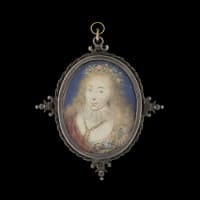There seems no reason to doubt the contemporary inscription on the reverse of this miniature stating that the miniature portrays the young Dorothy Percy. Around the date of this portrait, at the age of seventeen, she had secretly married Robert Sidney (1595–1677). Here, Dorothy wears a headdress of fresh flowers in her hair, reflecting her own bloom of youth.
In preparation for the 2019 exhibition ‘Jewel in the Hand’ held at the Philip Mould Gallery, research was undertaken which showed that this miniature may have once formed part of a set listed at Leicester House on the death of the 6th Earl in 1737.[1] Described within a group of limnings datable to before 1620, No. 7 is a ‘A Lady’s head with a laced ruff’ and No. 8 ‘Ditto with a garland of flowers’. This latter miniature, which matches the description of the present portrait, is unaccounted for by Sir Roy Strong when writing on this group for The...
There seems no reason to doubt the contemporary inscription on the reverse of this miniature stating that the miniature portrays the young Dorothy Percy. Around the date of this portrait, at the age of seventeen, she had secretly married Robert Sidney (1595–1677). Here, Dorothy wears a headdress of fresh flowers in her hair, reflecting her own bloom of youth.
In preparation for the 2019 exhibition ‘Jewel in the Hand’ held at the Philip Mould Gallery, research was undertaken which showed that this miniature may have once formed part of a set listed at Leicester House on the death of the 6th Earl in 1737.[1] Described within a group of limnings datable to before 1620, No. 7 is a ‘A Lady’s head with a laced ruff’ and No. 8 ‘Ditto with a garland of flowers’. This latter miniature, which matches the description of the present portrait, is unaccounted for by Sir Roy Strong when writing on this group for The Burlington Magazine. The other miniatures in this group, which were extant at the time are all annotated with what Strong noted as a ‘pre-Civil war hand’.[2] As the frame on this miniature is likely nineteenth century, it is probable that the sitter’s identity (also noted on the reverse in a ‘pre-Civil war hand’) was concealed by an original locket frame, and therefore the inventory maker was unable to identify her at the time.
Dorothy Percy was the daughter of Henry Percy, 9th Earl of Northumberland (1564–1632) and Dorothy Devereux, daughter of the Earl of Essex. Her husband was the youngest (but only surviving) son of Robert Sidney, 1st Earl of Leicester (1563–1626), and the union of Dorothy and Robert brought together two of the most powerful families in England.
Catharine MacLeod has recently explored the importance of Isaac Oliver’s role in fashioning the image of those in the Essex circle. She argues that ‘the patronage of Isaac Oliver by Robert Devereux, 2nd Earl of Essex, and his circle in the 1590s was central to both the development of the artist’s practice and to Essex’s campaign for power at court in the latter years of the reign of Elizabeth I’.[3] Although the present portrait dates to later in Oliver’s career, it is evidence of his enduring alliance to this influential family.
Both Dorothy and Robert had long and interesting lives – as a long-serving diplomat Robert travelled widely, finally retiring to Penshurst Place, where in 1649 he and Dorothy took in two of the children of the recently executed King Charles I. Their own sons, Philip, Lord Lisle, and Algernon were, however, loyal to the Commonwealth.
When the countess died in 1659 after 44 years of marriage, her widower announced his own imminent demise but in fact was to live for another eighteen years. This miniature records the youthful hope at the start of their enduring love affair.
[1] The inventory is transcribed in Harding, G. P. List of Portraits, Pictures In Various Mansions of the United Kingdom (I, 1804) pp.47-49 (National Portrait Gallery archives). This information taken Strong, R. (1985) ‘The Leicester House Miniatures: Robert Sidney, 1st Earl of Leicester and His Circle’, The Burlington Magazine, Vol. 128, No.991, pp. 694, 696-701, 703.
[2] Ibid.
[3] MacLeod, C. (2020) ‘Isaac Oliver and the Essex Circle’, British Art Studies, [online] Issue 17 [online] Available at: https://doi.org/10.17658/issn.... [accessed 07 Jan. 2021].







